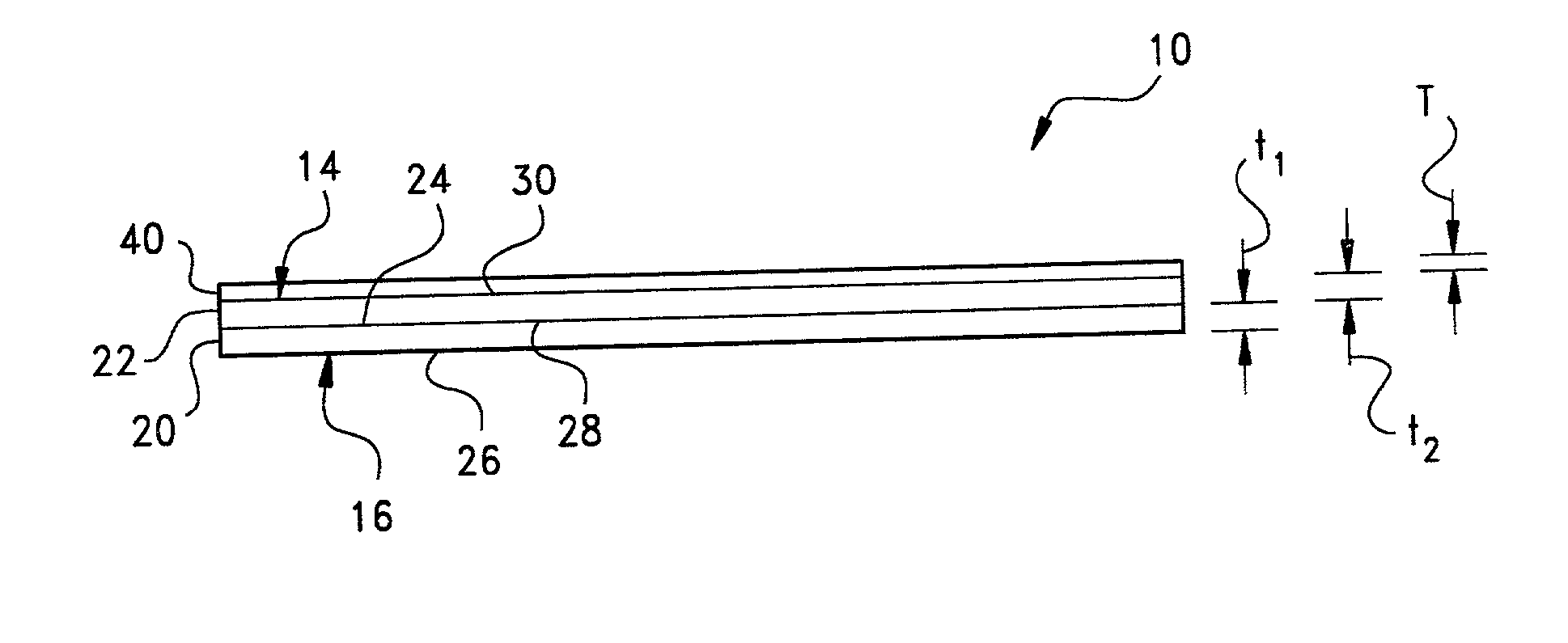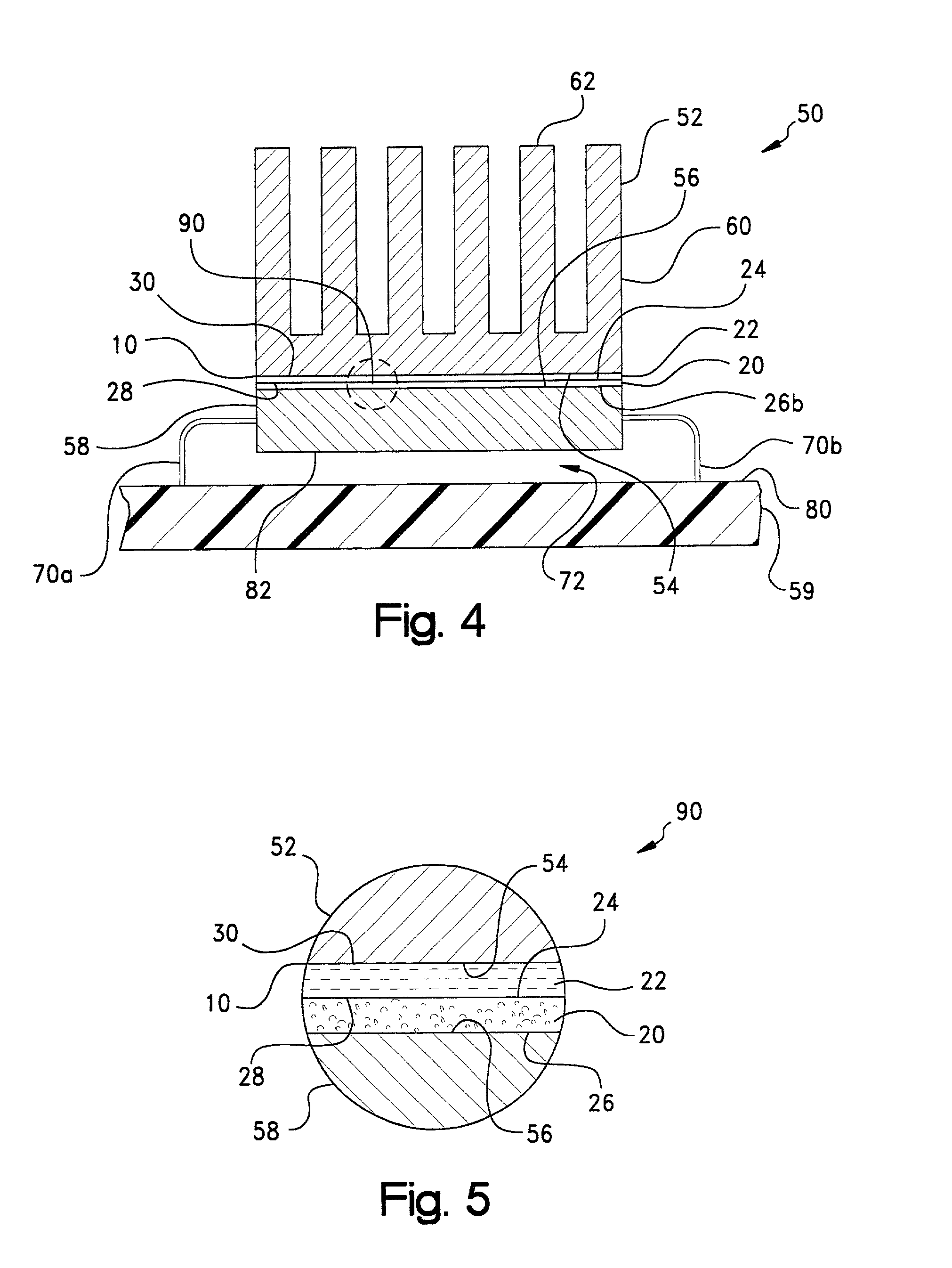Clean release, phase change thermal interface
a technology of phase change and thermal interface, which is applied in the direction of electrical apparatus construction details, transportation and packaging, chemistry apparatus and processes, etc., can solve the problem that the interface cannot be cleanly released from the component, and achieve the effect of low thermal impedan
- Summary
- Abstract
- Description
- Claims
- Application Information
AI Technical Summary
Benefits of technology
Problems solved by technology
Method used
Image
Examples
example 1
[0064] A 5 mil (125 .mu.m) thick layer of a boron-nitride filled PCM compound (Thermflow.TM. T725, Chomerics TEC Division, Parker Hannifin Corp., Hudson, N.H.) having a phase change temperature of about 58.degree. C., a thermal impedance of about 0.03.degree. C.-in.sup.2 / W (0.18.degree. C.-cm.sup.2 / W) at about 50 psi (350 kPa), and an apparent thermal conductivity of about 0.7 W / m-K was laminated to one surface of a 5 mil (125 .mu.m) thick sheet of a flexible graphite material (Grafoil.RTM. T705, Graftech, Inc., Cleveland, Ohio) having a thermal impedance of about 0.03.degree. C.-in.sup.2 / W (0.18.degree. C.-cm.sup.2 / W) at about 50 psi (350 kPa), and an apparent thermal conductivity of greater than about 7 W / m-K in the "z" or "through sheet" direction.
[0065] The thermal impedance of a sample of the interface material so prepared was determined using a modified ASTM D5470 procedure. A thermal impedance value of 0.091.degree. C.-in.sup.2 / W (0.546.degree. C.-cm.sup.2 / W) was measured whi...
example 2
[0066] A layer of the Thermflow.TM. T725 PCM used in Example 1 was laminated to one surface of a 1 mil (25 .mu.m) thick sheet of a flexible tin foil. The thermal impedance of this laminate was determined using a modified ASTM D5470 procedure. Comparative laminate samples also were prepared by coating the T725 PCM onto varying thickness of aluminum and copper foil, and on the Grafoil.RTM. T705 material used in Example 1. The results are shown in Table 1 below.
1 TABLE 1 Thickness (mils (.mu.m)) Impedance (C-in.sup.2 / W (.degree. C.-cm.sup.2 / W)) Sample PCM Substrate Total 10 psi (70 KPa) 20 psi (140 KPa) Aluminum 5.5 (140) 1 (25) 6.5 (165) 0.19 (1.22) 0.12 (0.77) Aluminum 3.5 (89) 1 (25) 4.5 (114) N / A 0.08 (0.52) Aluminum 9 (229) 1 (25) 10 (254) 0.203 (1.31) 0.125 (0.81) Aluminum 5 (127) 2 (51) 7 (178) N / A 0.16 (1.02) Aluminum 5 (127) 3 (76) 8 (203) N / A 0.18 (1.16) Grafoil .RTM. 5 (127) 3 (76) 8 (203) 0.144 (0.93) 0.087 (0.56) Grafoil .RTM. 5 (127) 5 (127) 10 (254) 0.151 (0.97) 0.12 (0....
PUM
| Property | Measurement | Unit |
|---|---|---|
| Percent by mass | aaaaa | aaaaa |
| Thickness | aaaaa | aaaaa |
| Thickness | aaaaa | aaaaa |
Abstract
Description
Claims
Application Information
 Login to View More
Login to View More - R&D
- Intellectual Property
- Life Sciences
- Materials
- Tech Scout
- Unparalleled Data Quality
- Higher Quality Content
- 60% Fewer Hallucinations
Browse by: Latest US Patents, China's latest patents, Technical Efficacy Thesaurus, Application Domain, Technology Topic, Popular Technical Reports.
© 2025 PatSnap. All rights reserved.Legal|Privacy policy|Modern Slavery Act Transparency Statement|Sitemap|About US| Contact US: help@patsnap.com



